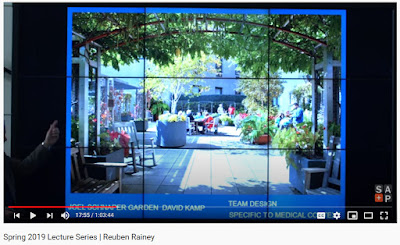Since mid 1990 there has been an emphasis in the approach of healing gardens / landscape design. Whoever has spent long hours waiting in the hallways of a hospital, or working, or as a patient, knows how stressful it could be. The proposed improvements were destined to buildings and the overall environment, including the outdoors. Current researches prove what we knew intuitively, that human connection with nature helps in our healing process: even the observation of a tiny flower, a colorful dry leaf, or of a spider web with beautiful raindrops, distracts us from everyday problems!. In SXXI therapeutic gardens designers began working with health professionals, recovered patients and their families' advices. Words like "Ecotherapy", "Terrapsychology", "Ecopsychology", "Green Exercise", "Biophilia", are common terms now. There are so many variables in design, that simulated nature was used for researchers to reduce the possible outcomes. And then the question arises, if simulated nature is still good and less expensive than landscape art (posters, murals, TV screens), why real nature is needed? Just for combined sensory experience.
I have watched professor emeritus Reuben Rainey's conference on YouTube about his experience and work in healing spaces in healthcare facilities. The conference was part of the Spring 2019 SA+P Lecture Series, University of Virginia.
I found it very interesting, though the noise in the background is annoying. This post is a summary of my notes together with some key screen shots images.
The professor shows a Healthcare facility of people with dementia. He reminds us that the landscape and hardscape is not only destined to the patients' relax but to the families and medical-nurses staff as well. It is important that patients are in contact with nature, able to touch and smell. So the design is highly tactile and multisensorial, with transition spaces (see the trellis above) for activities and veggie gardens.
Seating elements must be provided, though it is not specific what type, I personally prefer movable, so I can sit wherever I want, shadow, sunlight, twilight..... unless the seating is along a path. The edges are transparent so patients are able to see around and have more points of reference to avoid confusions.
The picture below is showing a floor plan, with the trellis in the center as a transition space, the landscape is extended around and there is a closed circuit for wheelchairs which guides the patients to come back. Professor Rainey comments designers should be careful with the budget. The construction of the hardscape-landscape could be a 20% of the overall budget of a facility but he says the extra amount usually turns back in two years.
The picture below shows a tall brick wall with an adjacent planter. He mentions one learns from its own mistakes. The adjacent planter allowed a tall patient to jump over the wall and land on the street.
The last part of the conference is dedicated to cancer patients. Here is a project with lots of glass in the corridors where the landscape can be seen through the tall windows. Natural light has healing power.
Cancer patients need to be in quietude. Absorbing sound materials are recommended. When chemo is underground, he proposes murals of landscapes (see photo below). He mentions it has been nice to see some people distract themselves looking for their own houses.
Apart from natural light, absorbing materials, glass and murals, he has incorporated "funny" paintings from a local artist to create a sense of familiarity. He says people find them very attractive to the point of being stolen :)
Each cow has its own name. People take pictures of them.
Professor Rainey says that more natural elements as symbolism had been added, but people fail to understand the theory and associate with memories. For example, stones and the beach. Stones are also used for calmness and meditation.
The view of the street is helpful for distraction as well. We can see proposed open terraces in the picture below. Trees are conforming edges.
In the picture above we see how landscape integrates with the spaces indoor.
The overall idea for Healthcare landscape- hardscape design is to stimulate inspiration and enthusiasm for life. It is a good idea to include flowers and colors.













No comments:
Post a Comment